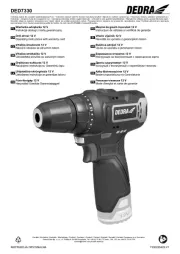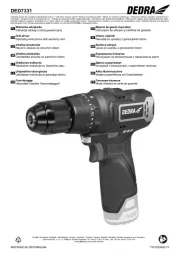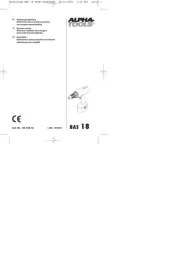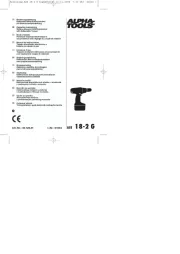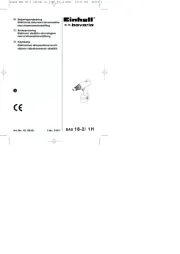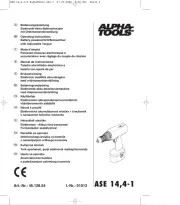WARNING: Important Safety Warnings and Instructions
TO REDUCE RISK OF INJURY:
• Before any use, be sure everyone using this tool reads and understands all safety instructions and other
information contained in this manual.
• Save these instructions and review frequently prior to use and in instructing others.
WARNING: When using electric tools, basic safety precautions should always be followed to
reduce risk of fire, electric shock, and personal injury, including the following.
READ ALL INSTRUCTIONS
General Safety Warnings and Instructions for All Tools
•KEEP WORK AREA CLEAN. Cluttered areas and benches invite injuries.
•CONSIDER WORK AREA ENVIRONMENT. Don’t expose power tools to rain. Don’t use power tools in
damp or wet locations. Keep work area well lit. Do not use in presence of flammable liquids or gases.
Motors in these tools normally spark, and the sparks may ignite the fumes.
•GUARD AGAINST ELECTRIC SHOCK. Prevent body contact with grounded surfaces. For example; pipes,
radiators, ranges, refrigerator enclosures. Use extreme caution when drilling, driving, or cutting into walls,
floors, ceilings or other areas or wherever live electrical wires may be contacted, do not touch any metal
parts of the tool. Hold the tools only by the plastic handle to prevent electric shock.
•KEEP CHILDREN AWAY. Do not let children and visitors contact tool or extension cord. All children and
visitors should be kept away from work area.
•STORE IDLE TOOLS. When not in use, tools should be stored in dry, and high or locked-up place–out of
reach of children.
•DON’T FORCE TOOL. It will do the job better and safer at the rate for which it was intended.
•USE RIGHT TOOL. Don’t force small tool or attachment to do the job of a heavy-duty tool. Don’t use tool
for purposes not intended.
•DRESS PROPERLY. Do not wear loose clothing or jewelry. They can be caught in moving parts. Rubber
gloves and non-skid footwear are recommended when working outdoors. Wear protective hair covering
to contain long hair.
•USE SAFETY GLASSES AND OTHER SAFETY EQUIPMENT. Use safety goggles or safety glasses with side
shields, complying with applicable safety standards and, when needed, a face shield. Also use face or
dust mask if cutting operation is dusty. This applies to all persons in the work area. Also use a hard hat,
hearing protection, gloves, safety shoes and dust collection systems when specified or required.
•DON’T ABUSE CORD. Never carry tool by cord or yank it to disconnect from receptacle. Keep cord from
heat, oil, and sharp edges.
•SECURE WORK. Use clamps or a vise to hold work. It’s safer than using your hand and it frees both hands
to operate tool.
•DON’T OVERREACH. Keep proper footing and balance at all times.
•MAINTAIN TOOLS WITH CARE. Keep tools sharp and clean for better and safer performance. Follow
instructions for lubricating and changing accessories. Inspect tool cords periodically and if damaged, have
repaired by authorized service facility. Inspect extension cords periodically and replace if damaged. Keep
handles dry, clean, and free from oil and grease.
•DISCONNECT TOOLS. Unplug the tool when not in use, when moving tool from place to place, before
servicing, and when changing accessories (such as blades, bits, cutters) or making adjustments.
•REMOVE ADJUSTING KEYS AND WRENCHES. Form habit of checking to see that keys and adjusting
wrenches are removed from tool before turning it on.
•AVOID UNINTENTIONAL STARTING. Don’t carry tool with finger on switch. Be sure switch is off when
plugging in.
•EXTENSION CORDS. Make sure your extension cord is in good condition. When using an extension cord,
be sure to use one heavy enough to carry the current your product will draw.An undersized cord will
cause a drop in line voltage resulting in loss of power and overheating. The following table shows the
correct size to use depending on cord length and nameplate ampere rating. If in doubt, use the next
heavier gage. The smaller the gage number, the heavier the cord.
•STAY ALERT. Watch what you are doing. Use common sense. Do not operate tool when you are tired or
otherwise impaired.
•CHECK DAMAGED PARTS. Before further use of the tool, a guard or other part that is damaged should be
carefully checked to determine that it will operate properly and perform its intended function. Check for
alignment of moving parts, binding of moving parts, breakage of parts, mounting, and any other
conditions that may affect its operation. A guard or other part that is damaged should be properly
repaired or replaced by an authorized service center. Do not use tool if switch does not turn it on and off.
•REPAIRS AND SERVICE. Repairs, maintenance and any adjustments not specified in this manual should be
performed by Black & Decker authorized service centers or other qualified service organizations, always
using identical replacement parts.
•USE OF ACCESSORIES AND ATTACHMENTS. The use of any accessory or attachment not recommended
for use with the tool could be hazardous. Note: Refer to the accessory section of this manual for further
details.
Safety Warnings and Instructions: Double Insulation
Double insulated tools are constructed throughout with two separate layers of electrical insulation or a
double thickness of insulation between you and the tool’s electrical system. Tools built with double insulation
are not intended to be grounded. As a result, your tool is equipped with a two prong plug which permits
you to use extension cords without concern for maintaining a ground connection.
Double insulation does not take the place of normal safety precautions when operating this tool. The
insulation system is for added protection against injury resulting from a possible electrical insulation failure
within the tool.
REPLACEMENT PARTS: When servicing use only identical replacement parts. Repair or replace damaged
cords.
Safety Warnings and Instructions: Polarized Plugs
Polarized plugs (one blade is wider than the other) are used on equipment to reduce the risk of electric
shock. When provided, this plug will fit into a polarized outlet only one way. If the plug does not fit fully
into the outlet, reverse the plug. If it still does not fit, contact a qualified electrician to install the proper
outlet. Do not change the plug in any way.
Motor
Your tool is powered by a Black & Decker built motor. Be sure your power supply agrees with the
nameplate marking. A marking of 120 volts, 50/60 Hz or 120 volts AC only means than the tool is
designed to operate on normal 120 volt house current. Voltage decrease of more than 10% will cause loss
of power and overheating. All Black & Decker tools are factory tested. If this tool does not run,
check the power supply.
R
Q270
INSTRUCTION MANUAL
1/2" (12.7 MM) 5.0 AMP
KEYLESS CHUCK DRILL
KEY INFORMATION YOU SHOULD KNOW:
•Hand tighten keyless chuck firmly after each bit
change.
•In order to operate, the drill must be in either the
hammer or drill mode.
1-800-54-HOW-TO
1-800-54-HOW-TO
1-800-54-HOW-TO
1-800-54-HOW-TO 1-800-54-HOW-TO
BEFORE RETURNING THIS PRODUCT
BEFORE RETURNING THIS PRODUCT
BEFORE RETURNING THIS PRODUCT
BEFORE RETURNING THIS PRODUCT BEFORE RETURNING THIS PRODUCT
FOR ANY REASON PLEASE CALL
FOR ANY REASON PLEASE CALL
FOR ANY REASON PLEASE CALL
FOR ANY REASON PLEASE CALLFOR ANY REASON PLEASE CALL
IF YOU SHOULD EXPERIENCE A PROBLEM
WITH YOUR PURCHASE,BLACK & DECKER
CALL .1-800-54-HOW-TO
IN MOST CASES, A REPRESENTATIVEBLACK & DECKER
CAN RESOLVE YOUR PROBLEM OVER THE PHONE.
IF YOU HAVE A SUGGESTION OR COMMENT,
GIVE US A CALL. YOUR FEEDBACK IS VITAL
TO THE SUCCESS OF BLACK & DECKER'S QUALITY
IMPROVEMENT PROGRAM.
VEA EL ESPAÑOL EN LA CONTRAPORTADA.
SAVE THIS MANUAL FOR FUTURE REFERERENCE.
INSTRUCTIVO DE OPERACIÓN, CENTROS DE SERVICIO Y PÓLIZA DE
GARANTÍA. ADVERTENCIA: LÉASE ESTE INSTRUCTIVO ANTES DE USAR EL
PRODUCTO.
CAT. NO. Q270 FORM NO. 373925 PRINTED IN ENGLAND (JAN 98 -1)
1Depth rod
Limiteur de profondeur
Varilla de profundidad
ESPECIFICACIONES
C# DR700 120V~ 580 W 60Hz 5,0A
Side handle
Poignée latérale
Mango lateral
Keyless chuck
Mandrin sans clé
Portabrocas sin llave
2
3A
Trigger switch
Interrupteur à détente
Gatillo Interruptor
Lock-on button
Bouton de verrouillage
Boton de encendido permanente
3B
Variable speed switch
Régulateur à cadran
Control de veloidad variable
Reversing switch
Inverseur de marche
Interruptor de reversa
REVERSE POSITION
MARCHE ARRIÈRE
POSICION DE REVERSA
FORWARD POSITION
MARCHE AVANT
POSICION DE MARCHA
Reversing switch
Inverseur de marche
Interruptor de reversa
Variable speed switch
Régulateur à cadran
Control de veloidad variable
4A 4B
56
Hammering position
Mode de percussion
Posicion de rotomartillo
Drilling position
Mode de perçage
Posicion de taladrado
Minimum Gage for Cord Sets
Volts Total Length of Cord in Feet
120V 0-25 26-50 51-100 101-150
240V 0-50 51-100 101-200 201-300
Ampere Rating
More Not more American Wire Gage
Than Than
0 - 6 18 16 16 14
6 - 10 18 16 14 12
10 - 12 16 16 14 12
12 - 16 14 12 Not Recommended











